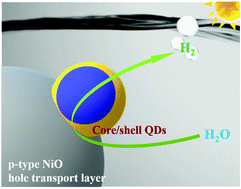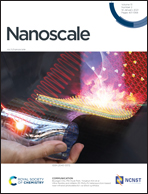Sensibilization of p-NiO with ZnSe/CdS and CdS/ZnSe quantum dots for photoelectrochemical water reduction†
Abstract
Core/shell quantum dots (QDs) paired with semiconductor photocathodes for water reduction have rarely been implemented so far. We demonstrate the integration of ZnSe/CdS and CdS/ZnSe QDs with porous p-type NiO photocathodes for water reduction. The QDs demonstrate appreciable enhancement in water-reduction efficiency, as compared with the bare NiO. Despite their different structure, both QDs generate comparable photocurrent enhancement, yielding a 3.8- and 3.2-fold improvement for the ZnSe/CdS@NiO and CdS/ZnSe@NiO system, respectively. Unraveling the carrier kinetics at the interface of these hybrid photocathodes is therefore critical for the development of efficient photoelectrochemical (PEC) proton reduction. In addition to examining the carrier dynamics by the Mott–Schottky technique and electrochemical impedance spectroscopy (EIS), we performed theoretical modelling for the distribution density of the carriers with respect to electron and hole wave functions. The electrons are found to be delocalized through the whole shell and can directly actuate the PEC-related process in the ZnSe/CdS QDs. The holes as the more localized carriers in the core have to tunnel through the shell before injecting into the hole transport layer (NiO). Our results emphasize the role of interfacial effects in core/shell QDs-based multi-heterojunction photocathodes.



 Please wait while we load your content...
Please wait while we load your content...